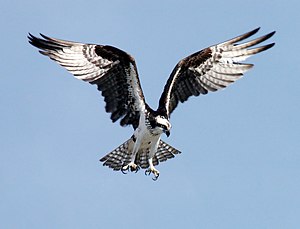Difference between revisions of "Field Guide/Birds/Pandion haliaetus"
m (moved Adventist Youth Honors Answer Book/Nature/Birds/Osprey to Field Guide/Birds/Pandion haliaetus: move to FG) |
m (89 revisions: re-import from WB, including edit history) |
(No difference)
| |
Latest revision as of 20:14, 5 July 2012
| Pandion haliaetus (Osprey) | |
|---|---|
| Description | |
| The Osprey, Pandion haliaetus is a medium-large raptor which is a specialist fish-eater with a worldwide distribution. It occurs in all continents except Antarctica, but in South America only as a non-breeding migrant. It is often known by other colloquial names such as fishhawk, seahawk or Fish Eagle.
The Osprey is 52-60 cm Juvenile birds are readily identified by the buff fringes to the upperpart plumage, buff tone to the underparts, and streaked crown. By spring, wear on the upperparts makes barring on the underwings and flight feathers a better indicator of young birds. Adult males can be distinguished from females from their slimmer bodies and narrower wings. They also have a weaker or non-existent breast band than the female, and more uniformly pale underwing coverts. It is straightforward to sex a breeding pair, but harder with individual birds. In flight, Ospreys have arched wings and drooping "hands", giving them a diagnostic gull-like appearance. The call is a series of sharp whistles, cheep, cheep, or yewk, yewk. Near the nest, a frenzied cheereek! The Osprey is particularly well adapted to its fish diet, with reversible outer toes, closable nostrils to keep out water during dives, and backwards facing scales on the talons which act as barbs to help hold its catch. It locates its prey from the air, often hovering prior to plunging feet-first into the water to seize a fish. As it rises back into flight the fish is turned head forward to reduce drag. The 'barbed' talons are such effective tools for grasping fish that, on occasion, an Osprey may be unable to release a fish that is heavier than expected. This can cause the Osprey to be pulled into the water, where it may either swim to safety or succumb to hypothermia and drown. The osprey breeds by freshwater lakes, and sometimes on coastal brackish waters. The nest is a large heap of sticks built in trees, rocky outcrops, telephone poles or artificial platforms. In some regions with high Osprey densities, such as Chesapeake Bay, USA, most ospreys do not start breeding until they are five to seven years old, and there may be a shortage of suitable tall structures. If there are no nesting sites available, young ospreys may be forced to delay breeding. To ease this problem, posts may be erected to provide more sites suitable for nest building. | |

